Accounting for Business: Financial Reports and Key Concepts
VerifiedAdded on 2023/06/18
|6
|1290
|246
Report
AI Summary
This report provides an overview of accounting for business, focusing on key accounting concepts such as the business entity concept, money measurement system, going concern concept, accounting period concept, and dual aspect concept. It further evaluates the qualitative characteristics of financial reports, emphasizing relevance through predictive and confirmatory value, and faithful representation including completeness, neutrality, and freedom from error. The report concludes that understanding these concepts and characteristics is crucial for users to make effective decisions based on trustworthy and relevant financial information. Desklib provides a platform for students to access this and many other solved assignments.
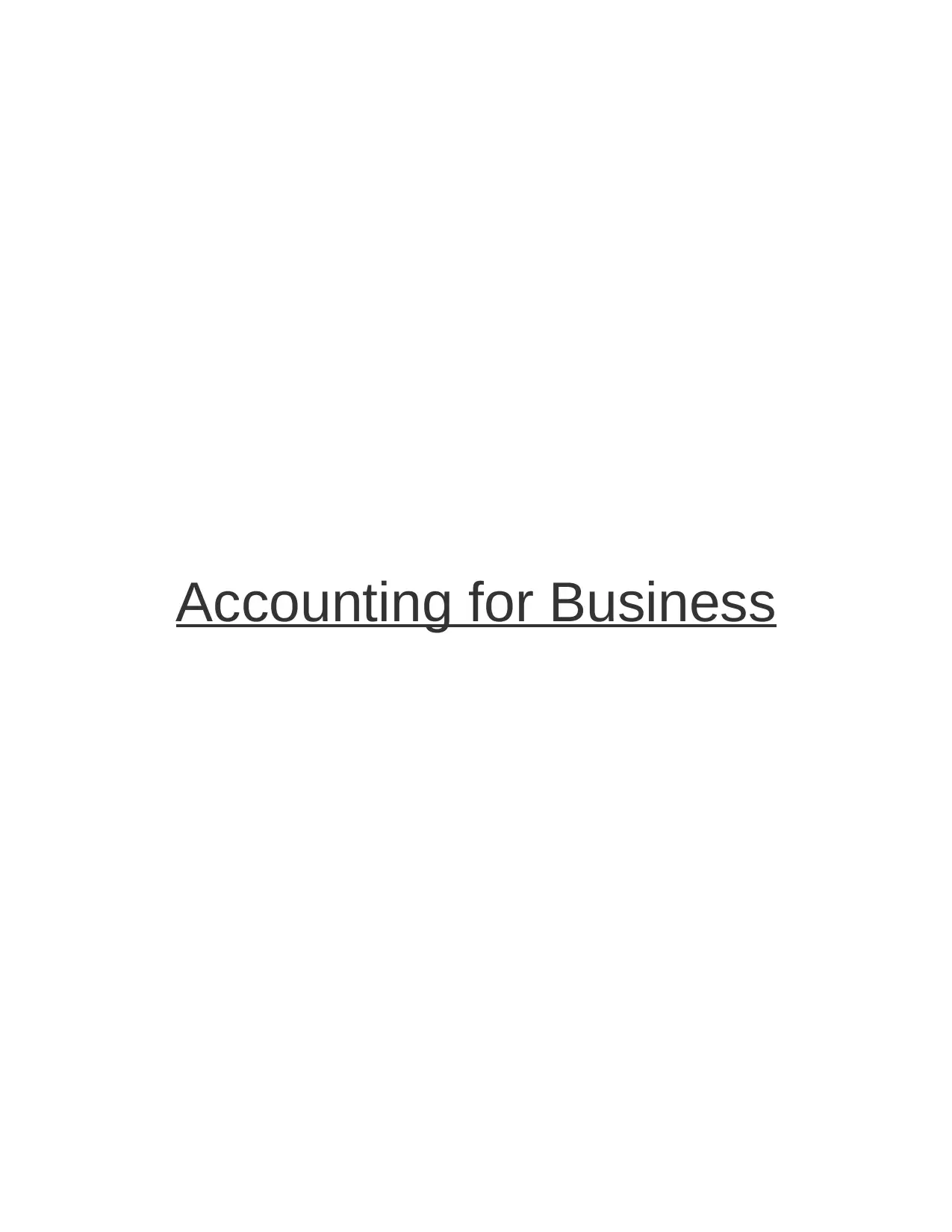
Accounting for Business
Paraphrase This Document
Need a fresh take? Get an instant paraphrase of this document with our AI Paraphraser
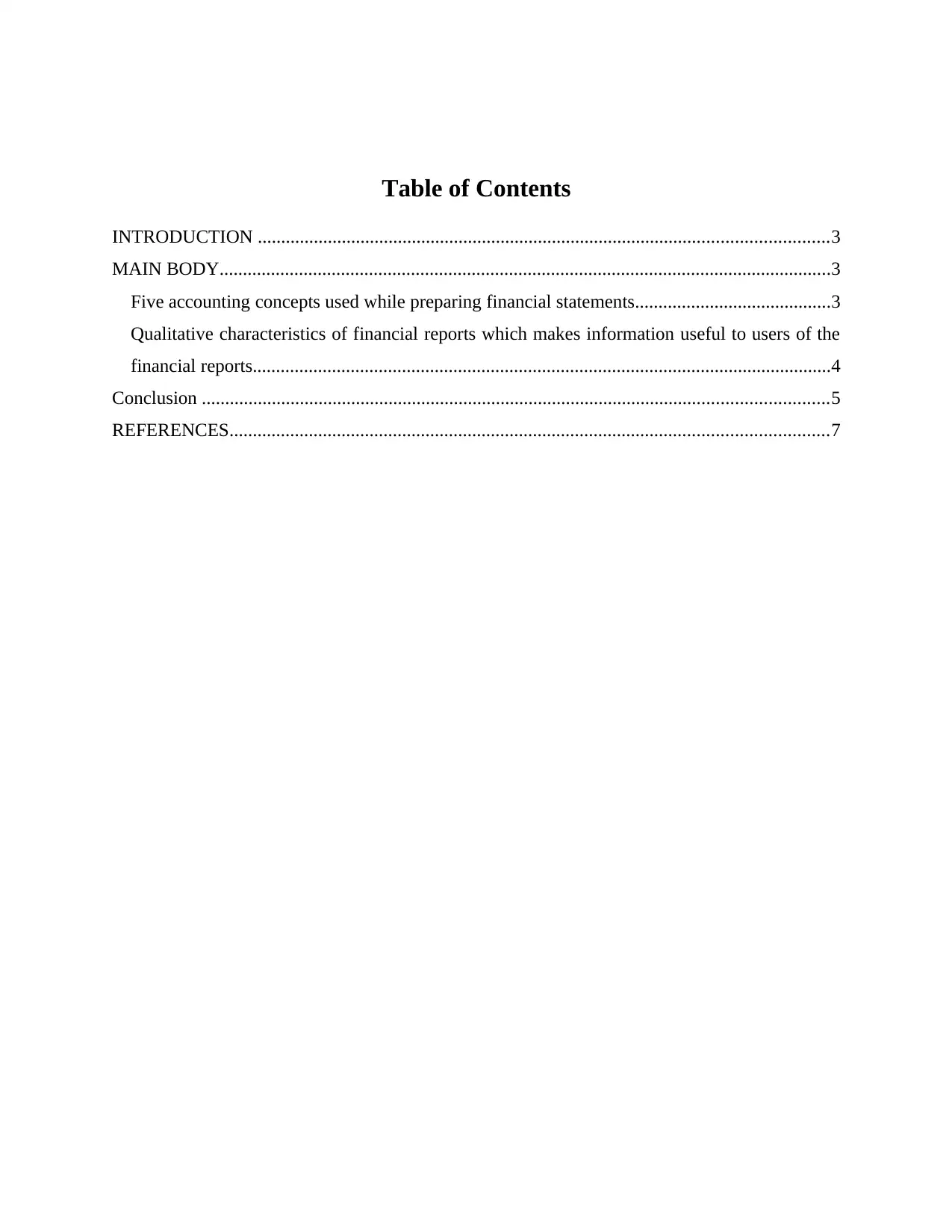
Table of Contents
INTRODUCTION ..........................................................................................................................3
MAIN BODY...................................................................................................................................3
Five accounting concepts used while preparing financial statements..........................................3
Qualitative characteristics of financial reports which makes information useful to users of the
financial reports............................................................................................................................4
Conclusion ......................................................................................................................................5
REFERENCES................................................................................................................................7
INTRODUCTION ..........................................................................................................................3
MAIN BODY...................................................................................................................................3
Five accounting concepts used while preparing financial statements..........................................3
Qualitative characteristics of financial reports which makes information useful to users of the
financial reports............................................................................................................................4
Conclusion ......................................................................................................................................5
REFERENCES................................................................................................................................7
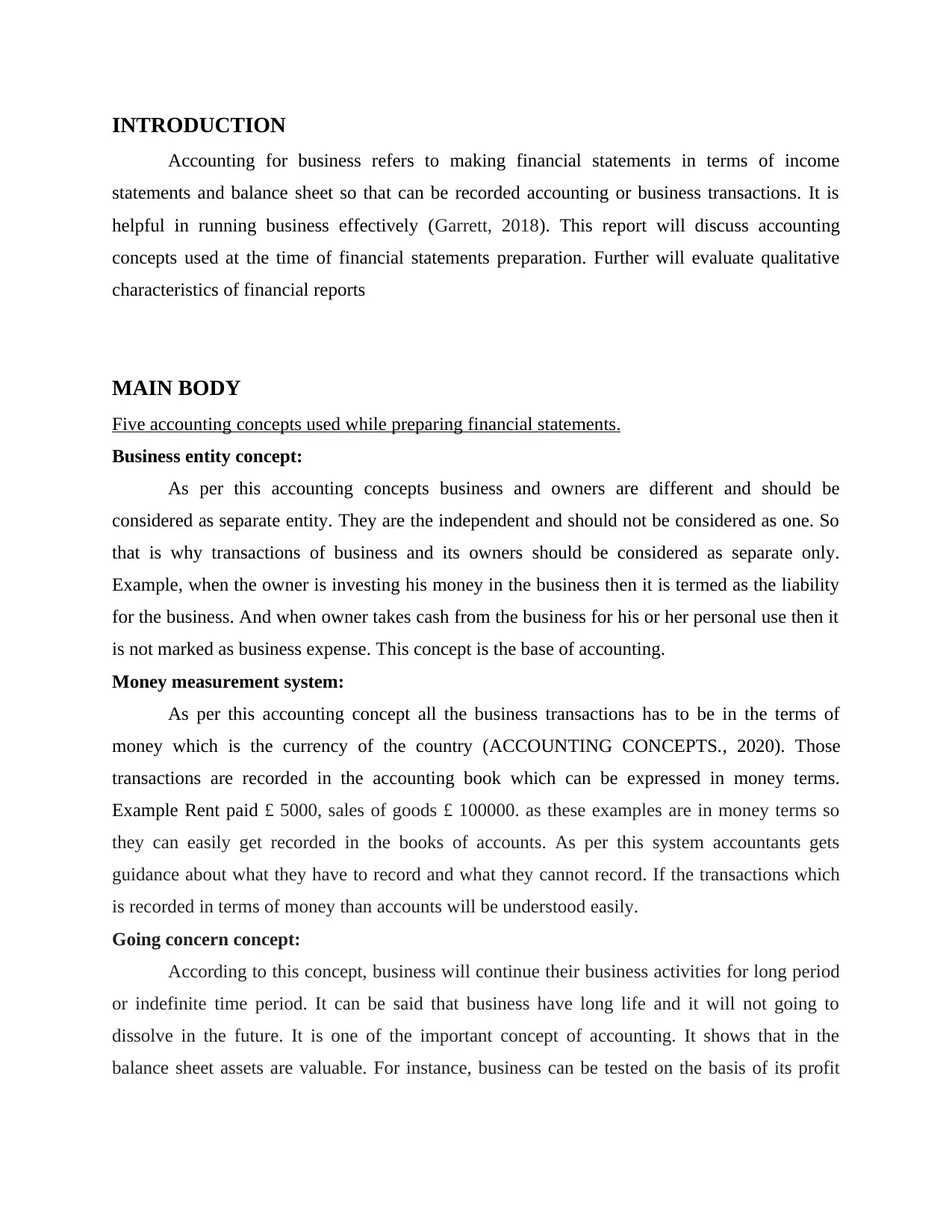
INTRODUCTION
Accounting for business refers to making financial statements in terms of income
statements and balance sheet so that can be recorded accounting or business transactions. It is
helpful in running business effectively (Garrett, 2018). This report will discuss accounting
concepts used at the time of financial statements preparation. Further will evaluate qualitative
characteristics of financial reports
MAIN BODY
Five accounting concepts used while preparing financial statements.
Business entity concept:
As per this accounting concepts business and owners are different and should be
considered as separate entity. They are the independent and should not be considered as one. So
that is why transactions of business and its owners should be considered as separate only.
Example, when the owner is investing his money in the business then it is termed as the liability
for the business. And when owner takes cash from the business for his or her personal use then it
is not marked as business expense. This concept is the base of accounting.
Money measurement system:
As per this accounting concept all the business transactions has to be in the terms of
money which is the currency of the country (ACCOUNTING CONCEPTS., 2020). Those
transactions are recorded in the accounting book which can be expressed in money terms.
Example Rent paid £ 5000, sales of goods £ 100000. as these examples are in money terms so
they can easily get recorded in the books of accounts. As per this system accountants gets
guidance about what they have to record and what they cannot record. If the transactions which
is recorded in terms of money than accounts will be understood easily.
Going concern concept:
According to this concept, business will continue their business activities for long period
or indefinite time period. It can be said that business have long life and it will not going to
dissolve in the future. It is one of the important concept of accounting. It shows that in the
balance sheet assets are valuable. For instance, business can be tested on the basis of its profit
Accounting for business refers to making financial statements in terms of income
statements and balance sheet so that can be recorded accounting or business transactions. It is
helpful in running business effectively (Garrett, 2018). This report will discuss accounting
concepts used at the time of financial statements preparation. Further will evaluate qualitative
characteristics of financial reports
MAIN BODY
Five accounting concepts used while preparing financial statements.
Business entity concept:
As per this accounting concepts business and owners are different and should be
considered as separate entity. They are the independent and should not be considered as one. So
that is why transactions of business and its owners should be considered as separate only.
Example, when the owner is investing his money in the business then it is termed as the liability
for the business. And when owner takes cash from the business for his or her personal use then it
is not marked as business expense. This concept is the base of accounting.
Money measurement system:
As per this accounting concept all the business transactions has to be in the terms of
money which is the currency of the country (ACCOUNTING CONCEPTS., 2020). Those
transactions are recorded in the accounting book which can be expressed in money terms.
Example Rent paid £ 5000, sales of goods £ 100000. as these examples are in money terms so
they can easily get recorded in the books of accounts. As per this system accountants gets
guidance about what they have to record and what they cannot record. If the transactions which
is recorded in terms of money than accounts will be understood easily.
Going concern concept:
According to this concept, business will continue their business activities for long period
or indefinite time period. It can be said that business have long life and it will not going to
dissolve in the future. It is one of the important concept of accounting. It shows that in the
balance sheet assets are valuable. For instance, business can be tested on the basis of its profit
⊘ This is a preview!⊘
Do you want full access?
Subscribe today to unlock all pages.

Trusted by 1+ million students worldwide
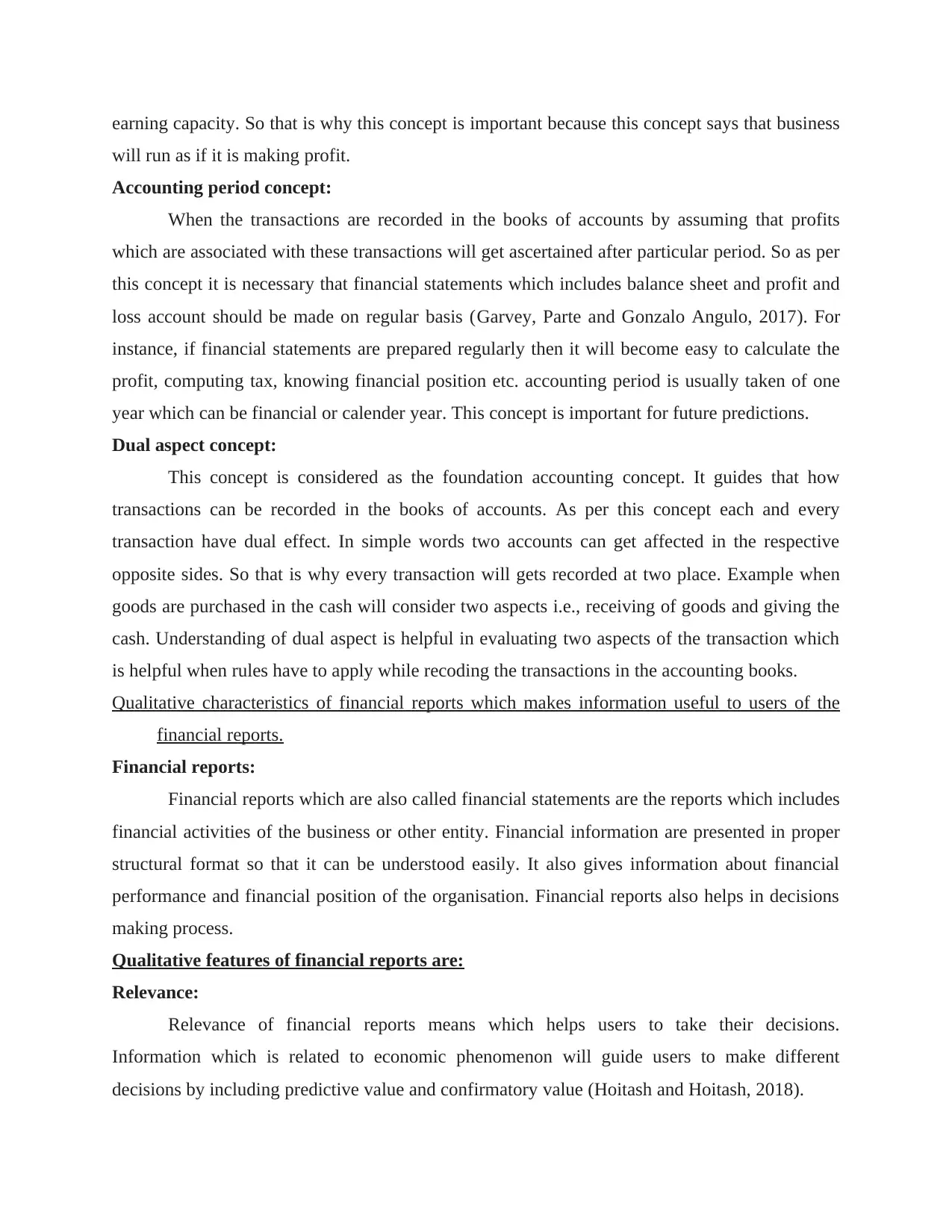
earning capacity. So that is why this concept is important because this concept says that business
will run as if it is making profit.
Accounting period concept:
When the transactions are recorded in the books of accounts by assuming that profits
which are associated with these transactions will get ascertained after particular period. So as per
this concept it is necessary that financial statements which includes balance sheet and profit and
loss account should be made on regular basis (Garvey, Parte and Gonzalo Angulo, 2017). For
instance, if financial statements are prepared regularly then it will become easy to calculate the
profit, computing tax, knowing financial position etc. accounting period is usually taken of one
year which can be financial or calender year. This concept is important for future predictions.
Dual aspect concept:
This concept is considered as the foundation accounting concept. It guides that how
transactions can be recorded in the books of accounts. As per this concept each and every
transaction have dual effect. In simple words two accounts can get affected in the respective
opposite sides. So that is why every transaction will gets recorded at two place. Example when
goods are purchased in the cash will consider two aspects i.e., receiving of goods and giving the
cash. Understanding of dual aspect is helpful in evaluating two aspects of the transaction which
is helpful when rules have to apply while recoding the transactions in the accounting books.
Qualitative characteristics of financial reports which makes information useful to users of the
financial reports.
Financial reports:
Financial reports which are also called financial statements are the reports which includes
financial activities of the business or other entity. Financial information are presented in proper
structural format so that it can be understood easily. It also gives information about financial
performance and financial position of the organisation. Financial reports also helps in decisions
making process.
Qualitative features of financial reports are:
Relevance:
Relevance of financial reports means which helps users to take their decisions.
Information which is related to economic phenomenon will guide users to make different
decisions by including predictive value and confirmatory value (Hoitash and Hoitash, 2018).
will run as if it is making profit.
Accounting period concept:
When the transactions are recorded in the books of accounts by assuming that profits
which are associated with these transactions will get ascertained after particular period. So as per
this concept it is necessary that financial statements which includes balance sheet and profit and
loss account should be made on regular basis (Garvey, Parte and Gonzalo Angulo, 2017). For
instance, if financial statements are prepared regularly then it will become easy to calculate the
profit, computing tax, knowing financial position etc. accounting period is usually taken of one
year which can be financial or calender year. This concept is important for future predictions.
Dual aspect concept:
This concept is considered as the foundation accounting concept. It guides that how
transactions can be recorded in the books of accounts. As per this concept each and every
transaction have dual effect. In simple words two accounts can get affected in the respective
opposite sides. So that is why every transaction will gets recorded at two place. Example when
goods are purchased in the cash will consider two aspects i.e., receiving of goods and giving the
cash. Understanding of dual aspect is helpful in evaluating two aspects of the transaction which
is helpful when rules have to apply while recoding the transactions in the accounting books.
Qualitative characteristics of financial reports which makes information useful to users of the
financial reports.
Financial reports:
Financial reports which are also called financial statements are the reports which includes
financial activities of the business or other entity. Financial information are presented in proper
structural format so that it can be understood easily. It also gives information about financial
performance and financial position of the organisation. Financial reports also helps in decisions
making process.
Qualitative features of financial reports are:
Relevance:
Relevance of financial reports means which helps users to take their decisions.
Information which is related to economic phenomenon will guide users to make different
decisions by including predictive value and confirmatory value (Hoitash and Hoitash, 2018).
Paraphrase This Document
Need a fresh take? Get an instant paraphrase of this document with our AI Paraphraser
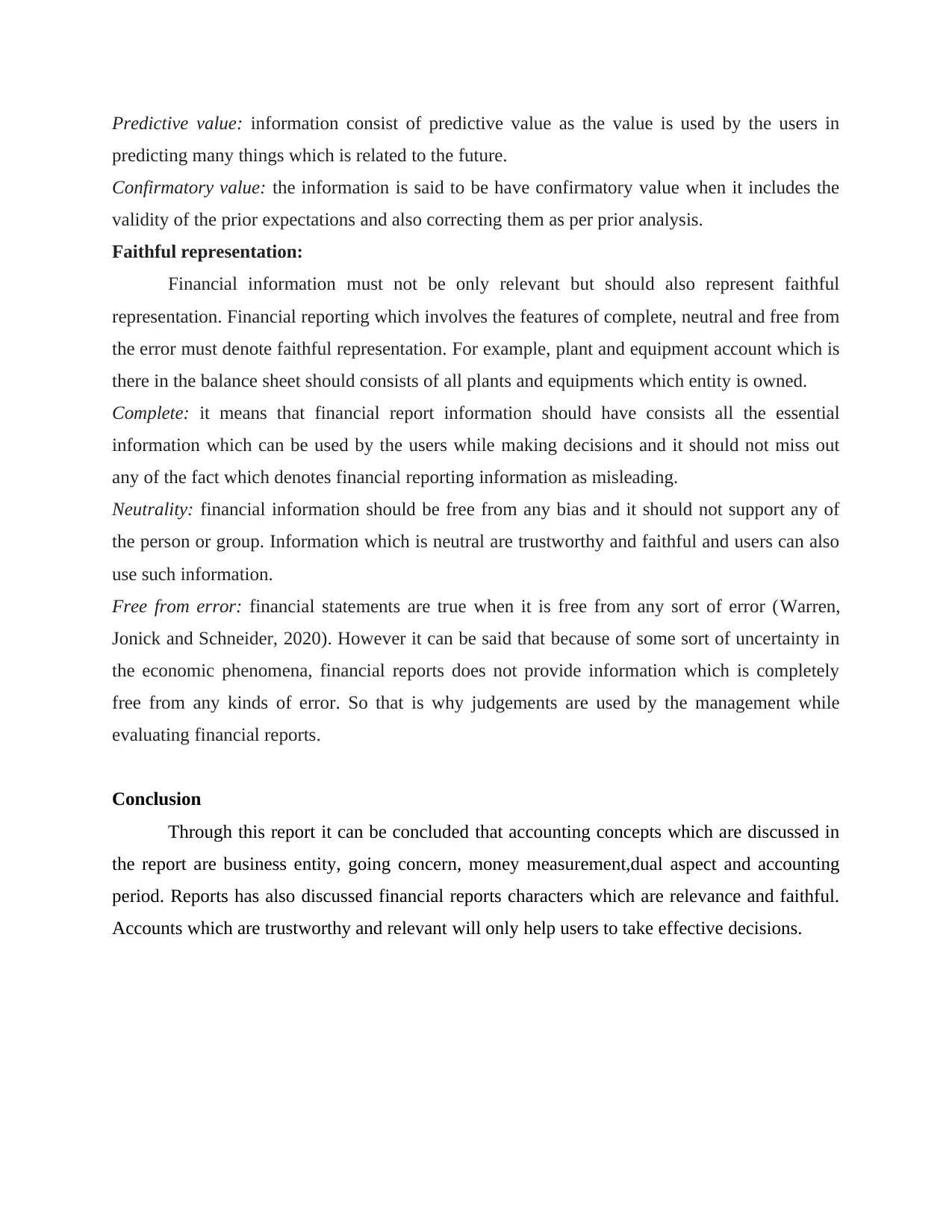
Predictive value: information consist of predictive value as the value is used by the users in
predicting many things which is related to the future.
Confirmatory value: the information is said to be have confirmatory value when it includes the
validity of the prior expectations and also correcting them as per prior analysis.
Faithful representation:
Financial information must not be only relevant but should also represent faithful
representation. Financial reporting which involves the features of complete, neutral and free from
the error must denote faithful representation. For example, plant and equipment account which is
there in the balance sheet should consists of all plants and equipments which entity is owned.
Complete: it means that financial report information should have consists all the essential
information which can be used by the users while making decisions and it should not miss out
any of the fact which denotes financial reporting information as misleading.
Neutrality: financial information should be free from any bias and it should not support any of
the person or group. Information which is neutral are trustworthy and faithful and users can also
use such information.
Free from error: financial statements are true when it is free from any sort of error (Warren,
Jonick and Schneider, 2020). However it can be said that because of some sort of uncertainty in
the economic phenomena, financial reports does not provide information which is completely
free from any kinds of error. So that is why judgements are used by the management while
evaluating financial reports.
Conclusion
Through this report it can be concluded that accounting concepts which are discussed in
the report are business entity, going concern, money measurement,dual aspect and accounting
period. Reports has also discussed financial reports characters which are relevance and faithful.
Accounts which are trustworthy and relevant will only help users to take effective decisions.
predicting many things which is related to the future.
Confirmatory value: the information is said to be have confirmatory value when it includes the
validity of the prior expectations and also correcting them as per prior analysis.
Faithful representation:
Financial information must not be only relevant but should also represent faithful
representation. Financial reporting which involves the features of complete, neutral and free from
the error must denote faithful representation. For example, plant and equipment account which is
there in the balance sheet should consists of all plants and equipments which entity is owned.
Complete: it means that financial report information should have consists all the essential
information which can be used by the users while making decisions and it should not miss out
any of the fact which denotes financial reporting information as misleading.
Neutrality: financial information should be free from any bias and it should not support any of
the person or group. Information which is neutral are trustworthy and faithful and users can also
use such information.
Free from error: financial statements are true when it is free from any sort of error (Warren,
Jonick and Schneider, 2020). However it can be said that because of some sort of uncertainty in
the economic phenomena, financial reports does not provide information which is completely
free from any kinds of error. So that is why judgements are used by the management while
evaluating financial reports.
Conclusion
Through this report it can be concluded that accounting concepts which are discussed in
the report are business entity, going concern, money measurement,dual aspect and accounting
period. Reports has also discussed financial reports characters which are relevance and faithful.
Accounts which are trustworthy and relevant will only help users to take effective decisions.
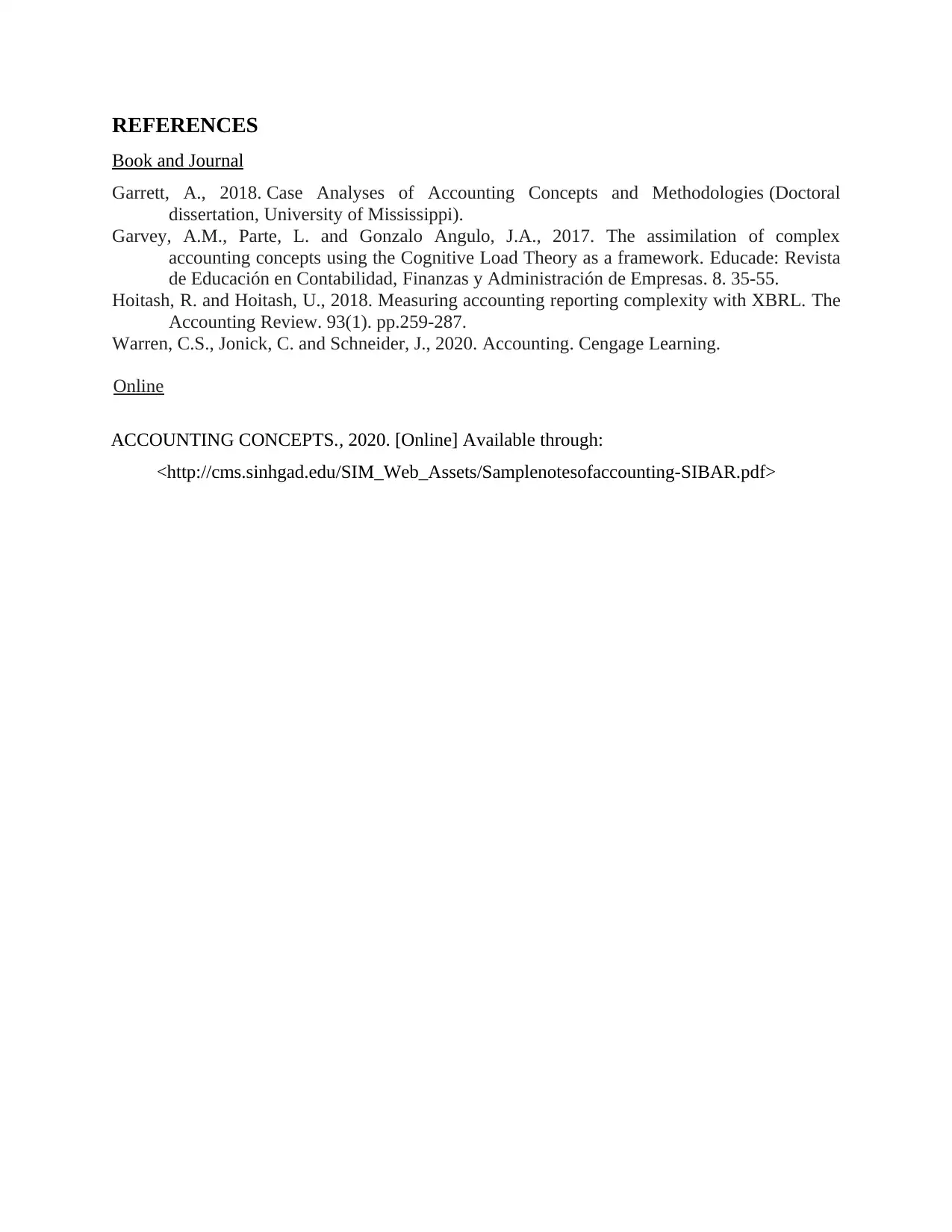
REFERENCES
Book and Journal
Garrett, A., 2018. Case Analyses of Accounting Concepts and Methodologies (Doctoral
dissertation, University of Mississippi).
Garvey, A.M., Parte, L. and Gonzalo Angulo, J.A., 2017. The assimilation of complex
accounting concepts using the Cognitive Load Theory as a framework. Educade: Revista
de Educación en Contabilidad, Finanzas y Administración de Empresas. 8. 35-55.
Hoitash, R. and Hoitash, U., 2018. Measuring accounting reporting complexity with XBRL. The
Accounting Review. 93(1). pp.259-287.
Warren, C.S., Jonick, C. and Schneider, J., 2020. Accounting. Cengage Learning.
Online
ACCOUNTING CONCEPTS., 2020. [Online] Available through:
<http://cms.sinhgad.edu/SIM_Web_Assets/Samplenotesofaccounting-SIBAR.pdf>
Book and Journal
Garrett, A., 2018. Case Analyses of Accounting Concepts and Methodologies (Doctoral
dissertation, University of Mississippi).
Garvey, A.M., Parte, L. and Gonzalo Angulo, J.A., 2017. The assimilation of complex
accounting concepts using the Cognitive Load Theory as a framework. Educade: Revista
de Educación en Contabilidad, Finanzas y Administración de Empresas. 8. 35-55.
Hoitash, R. and Hoitash, U., 2018. Measuring accounting reporting complexity with XBRL. The
Accounting Review. 93(1). pp.259-287.
Warren, C.S., Jonick, C. and Schneider, J., 2020. Accounting. Cengage Learning.
Online
ACCOUNTING CONCEPTS., 2020. [Online] Available through:
<http://cms.sinhgad.edu/SIM_Web_Assets/Samplenotesofaccounting-SIBAR.pdf>
⊘ This is a preview!⊘
Do you want full access?
Subscribe today to unlock all pages.

Trusted by 1+ million students worldwide
1 out of 6
Related Documents
Your All-in-One AI-Powered Toolkit for Academic Success.
+13062052269
info@desklib.com
Available 24*7 on WhatsApp / Email
![[object Object]](/_next/static/media/star-bottom.7253800d.svg)
Unlock your academic potential
Copyright © 2020–2025 A2Z Services. All Rights Reserved. Developed and managed by ZUCOL.




